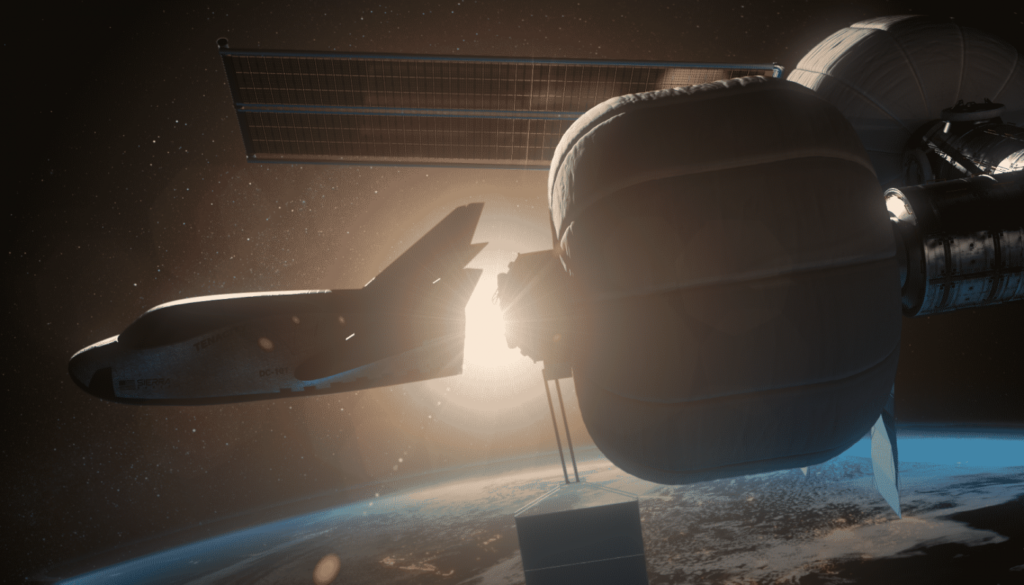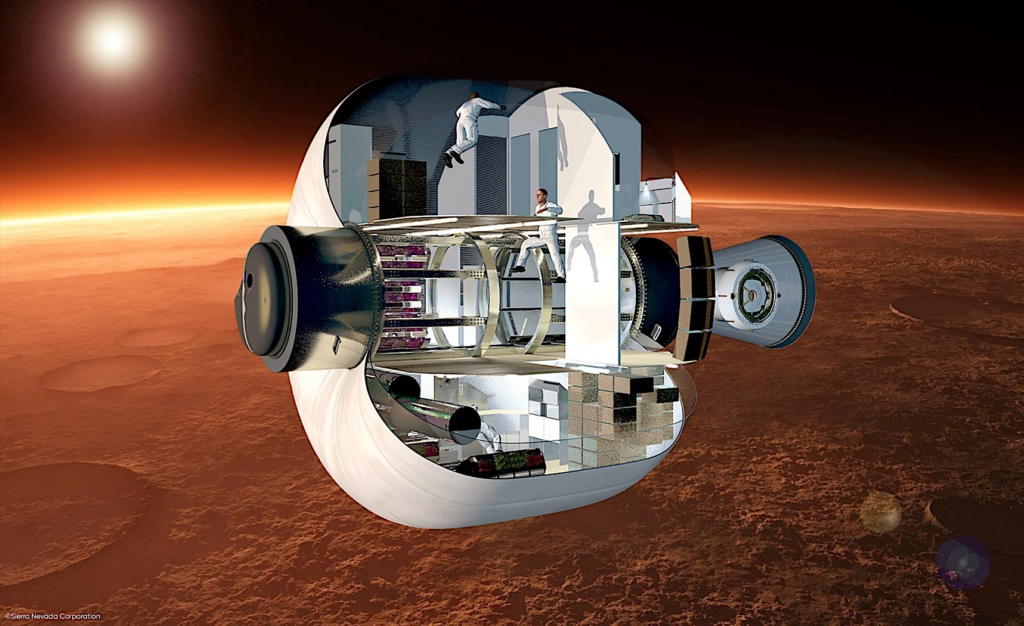When trying to build space stations, the cost and size of the structure is a major limiting factor. Launch vehicles are limited in how big of an object they can fit within their fairings and if you need multiple missions to assemble the structure, it will be very expensive. Sierra Space is trying to solve this with an inflatable habitat named LIFE.
LIFE stands for Large Integrated Flexible Environment and can expand to 27 feet or 8.2 meters when fully inflated. For months now we have watched pressure tests on smaller test articles to ensure it can withstand the space environment. However, the company just announced that they are about to test a full-scale system for the first time. Specifically, next month in December, at the NASA Marshall Space Flight Center in Huntsville, Alabama, they will push the unit to its limits.
The test will consist of continually pressurizing the inflatable until it bursts, gathering data on its exact limits and constraints. Here I will go more in-depth into this upcoming test, why it’s so significant, the future of inflatable habitats, and more.
Full-Scale Test

Only yesterday Sierra Space tweeted saying, “Our team is preparing for the biggest-ever “burst test” of our inflatable, expandable space station technology at @NASA_Marshall in Dec. 2023. This will be a significant milestone for Orbital Reef, in co-development with @BlueOrigin.” This included an image of teams preparing. The plan is to use these large inflatable modules in conjunction with regular modules on the Orbital Reef Station. Recently there was some confusion as to the future of Orbital Reef and the partnership between Sierra Space and Blue Origin. The two companies have since cleared this up and commented that they are committed to the project and each other.
Focusing back on LIFE, Sierra Space announced yesterday that it is on the brink of a historic moment as the company prepares for its biggest-ever “burst test” of Sierra Space’s inflatable, expandable space station technology. In a statement, the company said, “This groundbreaking endeavor marks a critical step in Sierra Space’s co-development of Orbital Reef with Blue Origin, as the company plans to stress test – for the first time in history – a full-scale version of its LIFE™ habitat structure and bring the unit to failure under pressure.” The LIFE module is constructed of high-strength “softgoods” materials, which are sewn and woven fabrics – primarily Vectran – that become rigid structures when pressurized on orbit.
Up until now, Sierra Space has conducted five stress tests on subscale test articles; this next one will be 18x larger – nearly 300 m³ of pressurized volume. This large jump in scale is what makes this upcoming test such a big deal. They go on to say that next month, the test is expected to provide Sierra Space and the Orbital Reef program team with critical data in support of NASA’s softgoods certification guidelines. The over-pressurization to failure during the test is not only meant to demonstrate the habitat’s capabilities but also open avenues for structural enhancements.
“Sierra Space’s inflatable space station module technology offers the absolute largest in-space pressured volume, the best unit economics per on-orbit volume and lowest launch and total operating costs,” said Sierra Space CEO Tom Vice. “Having the best unit economics positions Sierra Space as the category leader in microgravity research and product development – providing customers with the most attractive return on their investment” he said.
In terms of progress, by now, all components and ground support equipment are in the integration phase at NASA Marshall Space Flight Center. Next, softgoods integration into the test stand will be followed by transportation, utilizing the NASA transporter tractor, to the historic testing location adjacent to the flame trench of the Saturn 1/1B test stand — where NASA tested rockets for the Apollo program. Next, setup and calibration of sensors and cameras, alongside operational run-throughs, will prepare for the full-scale UBP test in December. Sierra Space aims to further refine its technical approach to safety factors and structural integrity through this test. They highlight that insights from previous tests contribute to technical maturation in support of higher-fidelity manufacturing processes. If successful, this test will make a major milestone for the company and the certification process of this technology.
LIFE Habitat

With the upcoming testing in mind, we can take a closer look at the exact design and plan with this technology. LIFE launches on a conventional rocket and inflates on orbit. The first product in the roadmap, LIFE 1.0, is a large, three-story structure that is 27 feet in diameter. It is intended to comfortably sleep four astronauts, with additional room for science experiments, exercise equipment, a medical center and Astro Garden® system, which can grow fresh produce for astronauts on long-duration space missions.
This LIFE 1.0 model has 285 cubic meters of volume. However, there is also a plan for a LIFE 2.0 and even 3.0. The 2.0 model will have 600 cubic meters of volume and the 3.0 variant will have an impressive 1200 cubic meters of volume. Obviously, before Sierra Space makes these large inflatable structures, they need some success with the 1.0 variant.
Sierra Space’s expandable space station module technology is trying to become highly scalable and flexible to all existing and planned launch vehicle fairing sizes. The softgoods structures launch packed inside conventional rocket fairings – 5m, 7m, 9m and beyond – inflating to capacity on orbit. Low-volume launches become high-volume space stations. The module volume will always be the square of its expansion diameter. For example, with a 2.5x expandable configuration, the volume would be 6.25x of a rocket fairing.
The way an intable structure can withstand the forces of space has to do with its unique materials and layers. First you have the restraint layer for LIFE is constructed of high-strength “softgoods” materials, which are sewn and woven fabrics – primarily Vectran – that become rigid structures when pressurized. Under normal operating pressure, the Vectran softgoods materials become 5x stronger than steel, exceeding station lifetime performance safety factors. The restraint layer is complemented by a bladder allowing controlled inflation and pressurization to ultimate burst pressure test failure. Two metallic blanking plates are strategically inserted into the restraint layer, designed for seamless integration into the structural shell with minimal performance degradation or knockdown; blanking plates are metal placeholders for integrating windows, airlocks, robotic arms and other features, into the softgoods layer. Together this creates a structure strong enough to withstand micrometeoroid impacts and other projectiles.
The LIFE habitat is currently being designed to support four crew members living and working on long-duration missions, such as those to Mars. Sierra Space highlights however that it comfortably houses six for missions in LEO, but can accommodate 12 crew for shorter periods of time such as those during which crew members transition. Because of its modular nature, additional habitats can be joined to each other to accommodate more crew, or for a variety of other purposes. The only main solid and noninflatable component is the vestibule which would be used to connect to other segments and leave or enter the habitat.
Starting years ago, Sierra Space set up a full-size mockup of the habitat including interior furnishing with various equipment that you would expect on an actual mission. Looking at an image of the second floor, you can see a crew work area with some computers and shelving. The floor and ceiling are also secured in place likely using sectional pieces that can be launched in a compact format for assembly in space. While the main habitat is inflatable, practically everything you put in it is not. In another image, it shows off the company’s Astro garden near the access hatch. Finally, moving up to the third floor, a look at the crew living area and galley table shows off the impressive space available.
Once in space, all of the air and water required to survive would be delivered by logistics carriers to the habitat, where it’s then stored until needed. The LIFE habitat has life support systems that regulate the air to maintain proper pressure, temperature, humidity, and oxygen levels. These life support systems recycle some of the air and water that is used to reduce the amount that has to be delivered to the habitat. In terms of getting it into space, the LIFE habitat is specifically designed to launch on commercial launch vehicles with a 5m fairing, providing multiple, low-cost launch options. It can also launch on the Space Launch System (SLS) since it expands only after it is on-orbit, making it easier and less expensive to transport. Once fully inflated, work would be done to outfit it with everything listed prior making it a relatively massive habitat in space.
Earlier this year in February, Sierra Space performed a month-long Accelerated Systematic Creep (ASC) test on LIFE – the first milestone in its 2023 testing campaign. Engineers loaded a one-third-scale version of the inflatable habitat with a sustained amount of pressure over an extended period until it failed. Per NASA’s recommended guidelines for inflatable softgoods certification, the test reached its goal of generating an additional data point – pressure and time to burst – which can be used to estimate the life of the primary pressure shell structure. Shawn Buckley, Sierra Space Cheif Engineer for LIFE said, “Our testing campaign has demonstrated that our LIFE habitat pressure shell design has a predicted life of far greater than 60 years – or 525,600 hours – based on Sierra Space’s 15-year on-orbit life requirement and the applied 4x safety factor. Now its time to see similar tests but on a full-scale variant.
Conclusion
Sierra Space is preparing for its most important LIFE habitat test yet expected to happen next month in December. This test will see the company push a full-size habitat to the limits until it explodes from the pressure. We will have to wait and see how it progresses and the impact it has on the space industry.
